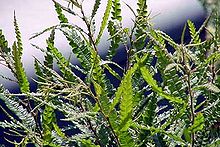Comptonia peregrina
| Sweetfern | |
|---|---|
 |
|
| Comptonia peregrina foliage | |
| Scientific classification | |
| Kingdom: | Plantae |
| (unranked): | Angiosperms |
| (unranked): | Eudicots |
| (unranked): | Rosids |
| Order: | Fagales |
| Family: | Myricaceae |
| Genus: | Comptonia |
| Species: | C. peregrina |
| Binomial name | |
|
Comptonia peregrina (L.) J.M.Coult. |
|
| Synonyms | |
|
Comptonia aspleniifolia (L.) L'Hér. |
|
Comptonia aspleniifolia (L.) L'Hér.
Comptonia is a monotypic genus (containing only Comptonia peregrina) in the family Myricaceae, order Fagales. It is native to eastern North America, from southern Quebec south to the extreme north of Georgia, and west to Minnesota. The common name is sweetfern or sweet-fern, a confusing name as it is not a fern.
It is a deciduous shrub, growing to 1.5 metres (4 ft 11 in) tall. The leaves of the plant are linear to lanceolate, 3–15 centimetres (1.2–5.9 in) long and 0.3–3 centimetres (0.12–1.18 in) broad, with a modified dentate, pinnately lobed margin; they give off a sweet odor, especially when crushed. The flowers are imperfect, meaning that no one flower has both sex parts. It tends to grow on dry sandy sites, and is associated with pine stands.
Comptonia peregrina is used as a food plant by the larvae of some Lepidoptera species, including Bucculatrix paroptila, grey pug, setaceous Hebrew character, Io moth, and several Coleophora case-bearers: C. comptoniella, C. peregrinaevorella (which feeds exclusively on Comptonia), C. persimplexella, C. pruniella and C. serratella. It is also a non-legume nitrogen fixer.
...
Wikipedia
